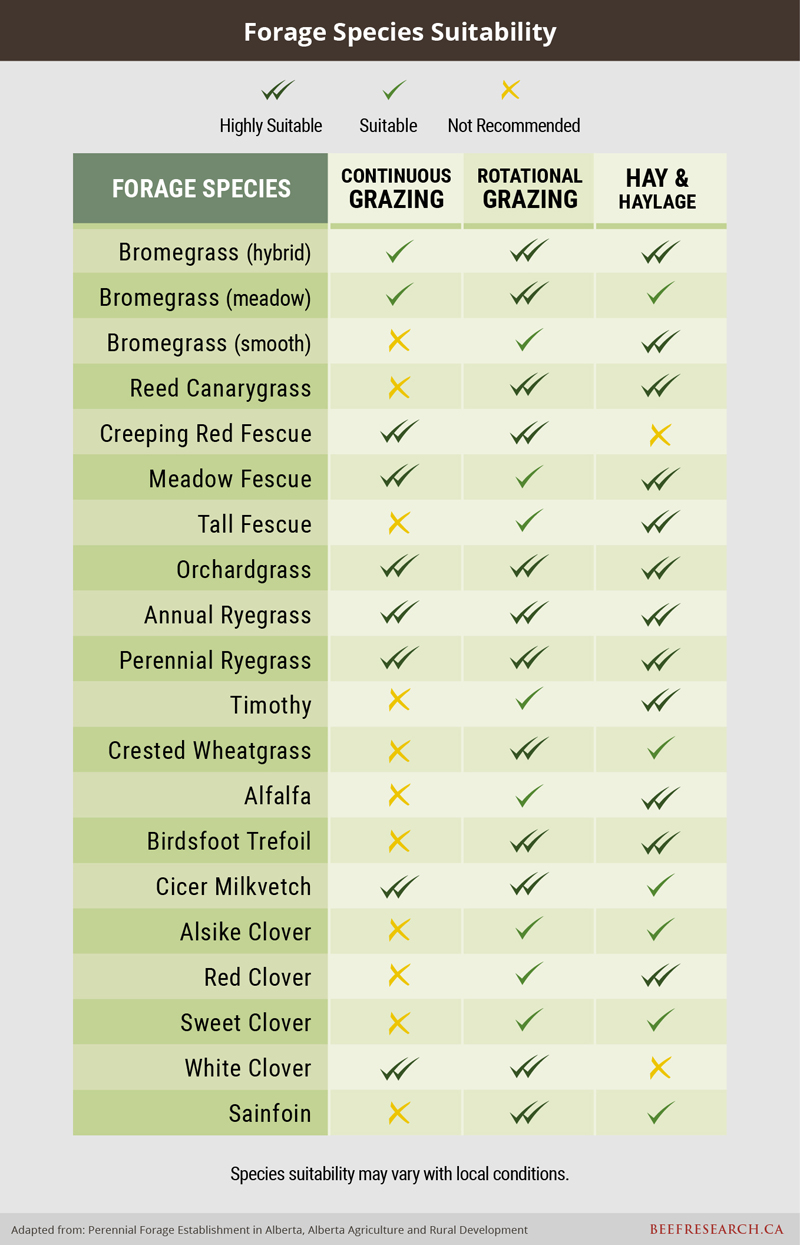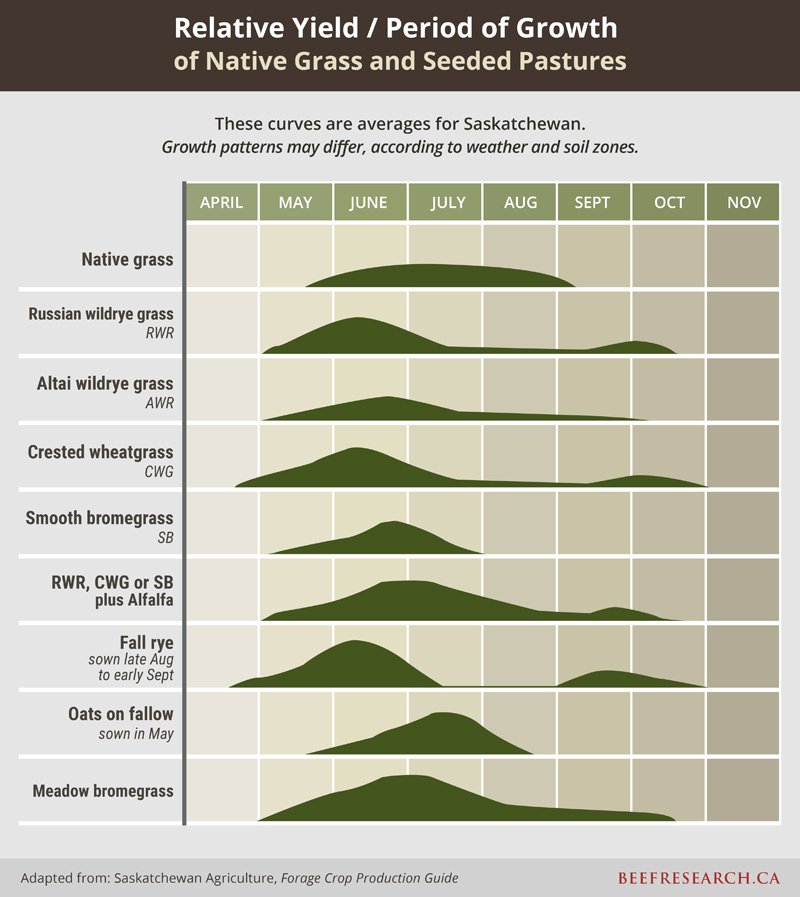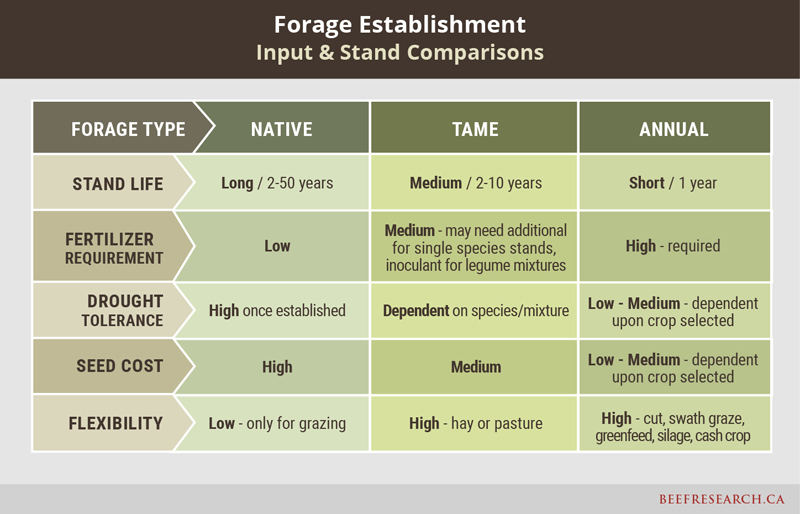Source: Beef Cattle Research Council, www.BeefResearch.ca
Land managers must carefully consider the long-term needs and goals for the forage stand and how it will function within their operation to select the appropriate species. Planning is key. Start at least 18 months prior to seeding to allow time for proper species selection, weed control, seedbed preparation, soil tests and pre-seeding fertilization. Perennial stands will usually be in production for many years, so treat it like a long-term investment. Environmental factors, intended use and stand life will impact forage species selection. Consider the land type, forage needs and utilization for the stand.
Consider the following:
- What is the intended use and when is the preferred season of use? Will it be pasture or hay? Will it be used for spring grazing, summer hay, fall or winter grazing?
- What is the management system? Will it be rotational, continuous, mob grazing?
- How long will the stand be in production?
- What are the specific environmental conditions, soil type, annual precipitation, winter temperatures, problem areas such as flooding, run-off, alkaline or saline areas?
- What are the specific herd needs?
- Is a single species or a binary mixture (two species) better suited to the requirements and environment? Can native species be used?
Intended Use of the Forage Stand
Forages vary in their suitability for hay and pasture, and for different management systems. Consider the use, frequency and type of harvest when determining stand composition. Native species, crested wheatgrass and low growing forages such as white or kura clover are not well suited to mechanical harvesting and are better utilized as part of a grazing system. Alfalfa, on the other hand, does not tolerate frequent grazing without stand loss, and unless managed carefully may be more suitable for haying. Other forages suitable for haying include smooth and hybrid brome grasses, rye grasses and timothy. How a stand will be managed will help determine species selection as certain varieties perform better under different conditions.
Timing of Use
Selection of the forage species will depend largely on when and how a producer wants to utilize the stand. Forage species vary in growth patterns, yield, nutrition levels and response to grazing or haying. Crested wheatgrass is an early season grass which could be suited to early turn-out at calving, or for pairs following calving. Alfalfa’s growth pattern fits well with rotational grazing, using rapid, even grazing, followed by a long rest period. Although it tolerates close grazing or haying, it does not tolerate continuous grazing. As with all species, native plants should be grazed during their optimal growth period and when growing conditions are favourable. Rest and recovery are the most important aspects when determining timing of use.
Single Species or Mixture?
To determine whether single species or a mixture provides the best option for the new forage stand, producers consider many factors. Single species work well for single end uses, while mixtures, such as grass-legume blends can provide more options, such as harvesting for hay or silage as well as grazing. To increase protein levels and digestibility of forage, producers often consider a forage mixture that contains a legume such as alfalfa. Grass species that grow well when planted with alfalfa include: meadow bromegrass, timothy, crested wheatgrass, orchard grass and tall fescue. Mixtures containing 30-40% legume can usually produce enough nitrogen for their needs, reducing the need for regular applications of nitrogen fertilizer. Grass-alfalfa mixtures can reduce risk of bloat, while increasing the length of the grazing season.
Research conducted by Dr. Yousef Papadopoulos at Agriculture and Agri-Food Canada’s Experimental Farm in Nappan, Nova Scotia examined four different pasture blends. The combinations consisted of timothy, meadow fescue, reed canarygrass, Kentucky bluegrass, tall fescue, meadow brome and orchard grass with either birdsfoot trefoil or alfalfa. Yields were higher with the alfalfa blends, yet animal performance was better on the blends containing trefoil. Over the five years of the trial, both legumes declined in the stands, affecting both yield and performance. Results are highly variable and forage mixtures may exhibit different results across the many regions of Canada.
| Longevity and yield of a forage stand begins with choosing a variety adapted to the intended use, environment and field conditions. High quality Certified seed is recommended as it provides legal guarantees for varietal purity, germination, and freedom from impurities such as weed seeds. |
In the following webinar, Dr. Surya Acharya discusses new forage varieties and research at Agriculture Agri-Food Canada Lethbridge Research and Development Centre.
Tame vs. Native Grasses
While tame forage species are often the first choice for producers establishing a new stand due to reduced cost, seed availability and faster establishment, native species can outperform in certain growth limiting environments over the long term once well established. Under optimum conditions, tame forages can have higher yields, and offer flexibility in terms of cutting for hay, or swath grazing, while native rangelands and pastures on marginal landsexhibit drought tolerance and resilience. Where possible, preserve and maintain native species; choose lands for new forage establishment that would benefit from having perennial cover, such as areas prone to excess moisture, or run-off and erosion. Producers on mixed operations must consider the opportunity cost of higher valued land when it is seeded to forages. Less productive land is often a better fit for establishing or re-establishing native stands. The table below illustrates yield and period of growth of native grasses in Saskatchewan, relative to several common tame grasses and annuals.
Seeding Annual Crops as Forage
Seeding an annual, such as barley, oats, triticale or ryegrass as a forage source can provide additional feed, tonnage or grazing flexibility. Annuals can provide rest and recovery of perennial pastures from grazing, as well as supplement feed during drought, or late seeding options when excessive spring moisture prevents normal seeding of annuals. Fall seeded winter cereals can be grazed in mid-May, reducing pressure on pasture. Annuals can also extend the grazing season and provide excellent quality feed if grazed or cut for greenfeed hay, swath grazing or silage.
The inclusion of a field or forage pea can boost protein levels. Intercropping involves planting a spring cereal with a winter annual, allowing the flexibility to harvest spring cereal for silage, and leave the winter cereal below for mid to late season grazing. Another use of annuals is as a cover crop. They can provide a quick-growing source of forage and can be grazed in the season they are planted. There is much interest in cover crops/poly crops by both livestock producers and farmers as a feed source and a means to improve soil properties. Research is ongoing in this area.
The following table summarizes key characteristics and comparisons of native, tame, and annual forages.
Companion Crops
Companion or nurse crops can be useful in suppressing weeds and reducing erosion, can provide protection from the elements for forage stand establishment, and provide extra feed during the first year when cut early as silage or greenfeed. In certain areas of Canada, such as the Maritimes, forage crops have traditionally been under seeded with a cereal companion or nurse crop. Forages such as red clover, timothy and rye grasses seem to establish better in a companion system than alfalfa and most other grasses. A companion crop will always compete with the forage crop for nutrients, light, and moisture. This can reduce the survival rate and subsequent yield of the forage stand. Select the companion crop species to minimize competition with the forage species selected for the stand. Companion crops should be seeded at half the normal rate and harvested early to reduce competition to the main forage stand after it has established.
In drier regions, success with companion crops is limited. Research at three sites in Saskatchewan over a three-year period examined the use of annual crops such as field pea, canola and ryegrass as companion crops for establishment of forages. The economic returns were worse with a companion crop at two locations, Swift Current and Saskatoon, but slightly better at Nipawin1. This research demonstrated that the feasibility of companion crops for establishment of short-lived perennial forages in Saskatchewan depends on soil zone, with the more humid areas being the best suited to the use of companion crops.












